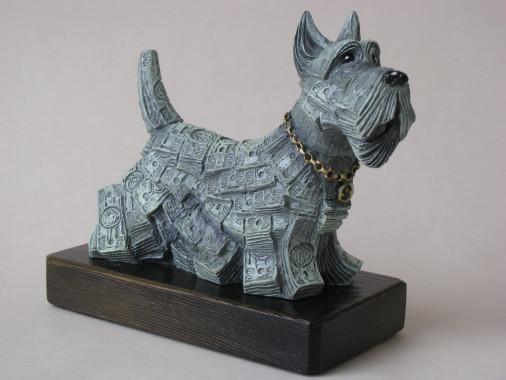Wooden sculptures
(2)The enduring charm of wooden sculpture: contemporary exploration
Wooden sculpture, an art form that dates back to ancient times, continues to captivate audiences with its warmth, versatility, and organic beauty. In recent years, the world of contemporary wooden sculpture has seen an intriguing blend of traditional methods and innovative designs, creating pieces that are both aesthetically pleasing and deeply meaningful.
The primary allure of wooden sculpture lies in the medium itself. Wood, with its organic warmth and inherent textures, offers a tactile experience that few other materials can. Each grain, knot, and imperfection tells a story, making every sculpture unique. The choice of wood - from the sturdy oak to the supple willow - plays a critical role in shaping the sculpture's character and longevity. Wooden sculptures often carry a wealth of symbolism. In many cultures, wood is seen as a living material, imbued with spirit and meaning. The natural life cycle of wood - from growth to decay - can also be metaphorically powerful in art, symbolizing themes from growth and resilience to mortality.
Wooden sculpture has been a fundamental part of human expression across cultures and ages. Asmat wooden sculpture, originating from the Asmat people of Papua New Guinea, is another fascinating example. These sculptures are deeply rooted in the Asmat culture, often representing ancestors and holding significant spiritual value. From the totem poles of indigenous cultures to the refined statues of Renaissance Europe, wood has been shaped to convey religious, cultural, and personal narratives. Understanding a wooden sculpture often involves delving into its historical and cultural context, which enriches the viewing experience.
The versatility of wood allows for a range of styles and techniques. Traditional carving methods, where the artist removes material to reveal the form, contrast with modern techniques that might incorporate assembling or integrating different materials with wood. The style can range from the hyper-realistic to the abstract, each presenting a different challenge and requiring different skills from the artist.
Ukrainian wooden sculpture: blend of tradition and artistry
One remarkable aspect of wooden sculpture is its global appeal and diversity. Ukrainian wooden sculpture, for instance, showcases a deep connection to cultural heritage and folklore, often featuring intricate carvings and traditional motifs. These sculptures not only serve as artistic pieces but also as a medium to keep Ukrainian traditions alive.
The tradition of wooden sculpture in Ukraine dates back centuries, closely tied to the country's rural and folkloric traditions. Originally, these sculptures served practical purposes, such as architectural elements in churches and homes, or as household utensils. Over time, they evolved into more elaborate forms, becoming symbols of artistic and cultural expression. Ukrainian wooden sculptures are not merely artistic objects; they are embodiments of the country's soul and history. They play a crucial role in preserving and promoting Ukrainian cultural identity, especially in times of change and challenge. As tangible pieces of heritage, they connect the past with the present, keeping the stories and traditions of Ukraine alive.
Ukrainian wooden sculptures often feature a range of motifs and themes, deeply embedded in Slavic mythology and local traditions. Common themes include:
- Religious Iconography. Many sculptures depict saints and biblical scenes, reflecting the deep-rooted spirituality in Ukrainian culture.
- Nature and Mythology. Elements from nature, like animals and trees, are frequently depicted, often intertwined with mythological figures and stories.
- Daily Life. Scenes from rural life, showcasing the customs, occupations, and festivities of Ukrainian villages.
The art of Ukrainian wooden sculpture is characterized by its intricate carving techniques and the use of native woods. These styles vary from region to region, offering a diverse range of artistic expressions. Carpathian style, known for its elaborate carvings and intricate details, often depicting scenes from nature and folklore. Polissya style - more simplistic and abstract, focusing on the symbolic representation of figures and themes.
Contemporary relevance of wooden sculpture
In the contemporary art scene, wooden sculpture challenges and expands the boundaries of traditional sculpture. Artists experiment with scale, form, and technology to reinterpret wood in innovative ways. Some contemporary wooden sculptures might comment on environmental issues, reflecting the artist's concerns about deforestation and sustainability.
In contemporary Ukraine, wooden sculpture has experienced a resurgence, with artists both preserving traditional methods and exploring new, creative directions. Contemporary sculptors are not only keeping the ancient skills alive but also using them to comment on current social and political themes, making these sculptures relevant to new generations.
Similarly, KAWS, an American artist and designer, brings a contemporary twist to wooden sculpture. His creations, often large-scale and featuring his iconic characters, blend commercialism, street culture, and fine art. KAWS' wooden sculptures are not just visual treats but also commentaries on modern society, blurring the lines between art and consumerism.
In places like Tulum, wooden sculpture takes on a more spiritual and nature-centric approach. Tulum's wooden sculptures often embody the region's rich history and its relationship with the natural world, making them not just artistic expressions but also pieces that resonate with the area's soul.
The versatility of wooden sculpture is evident in its varied forms. Abstract wooden sculptures challenge the viewers' perceptions, using form, texture, and the natural qualities of wood to convey emotions and ideas. Kinetic wooden sculptures add the dimension of movement, bringing an interactive and dynamic aspect to the art form. Contemporary wooden sculpture pushes the boundaries of this traditional material, incorporating modern techniques and concepts. Carved wooden sculptures, whether depicting human figures, animals, or abstract forms, showcase the skill and precision of the artist, while animal and bird wooden sculptures bring the natural world into our homes, serving as stunning pieces of wooden sculpture decor.
The beauty of wooden sculpture lies not just in its visual appeal but also in its ability to evoke emotions and thoughts. From the amazing wooden sculptures that leave us in awe to the smaller pieces that adorn our living spaces, wooden sculpture remains a vital and ever-evolving art form. It's a testament to the enduring appeal of wood as a medium and the endless creativity of the artists who shape it.


